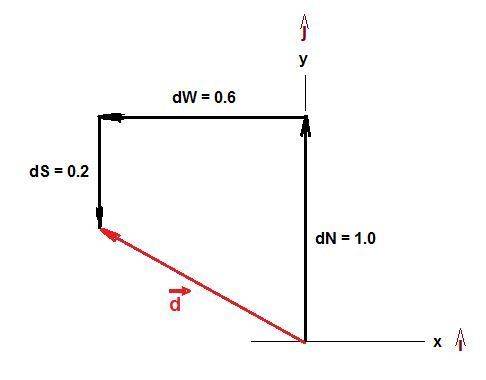
Astudent bikes to school by traveling first dn = 1.00 miles north, then dw = 0.600 miles west, and finally ds = 0.200 miles south. take the north direction as the positive y direction and east as positive x. the origin is still where the student starts biking. let d⃗ n be the displacement vector corresponding to the first leg of the student's trip. express d⃗ n in component form

Answers: 1
Other questions on the subject: Physics

Physics, 22.06.2019 10:30, austinwst3
You are driving directly behind a pickup truck, going at the same speed as the truck. a crate falls from the bed of the truck to the road. (a) will your car hit the crate before the crate hits the road if you neither brake nor swerve? (b) during the fall, is the horizontal speed of the crate more than, less than, or the same as that of the truck?
Answers: 2

Physics, 22.06.2019 11:00, natalieburnett82
Marcella is a four-year-old girl who is a victim of emotional child abuse. based on the child and family services improvement and innovation act of 2011, which action should the government take for marcella? a. the state should arrest marcella’s abuser. b. the state should find a home for marcella as soon as possible. c. the state should enforce stricter laws in the area where marcella resides. d. the state should provide medical assistance to marcella.
Answers: 3

Physics, 22.06.2019 15:00, banna01man
Greg drew a diagram to compare two of the fundamental forces. which labels belong in the areas marked x, y and z? gravitational force electromagnetic force x. attractive y repulsive z: infinite range x: infinite range y attractive z. repulsive x. always attractive y: infinite range z: attractive or repulsive x. attractive or repulsive y infinite range z: always attractive
Answers: 2

Physics, 22.06.2019 17:50, manou76
Two identical stars with mass m orbit around their center of mass. each orbit is circular and has radius r, so that the two stars are always on opposite sides of the circle. (a) find the gravitational force of one star on the other. (b) find the orbital speed of each star and the period of the orbit. (c) how much energy would be required to separate the two stars to infinity?
Answers: 1
Do you know the correct answer?
Astudent bikes to school by traveling first dn = 1.00 miles north, then dw = 0.600 miles west, and f...
Questions in other subjects:





Computers and Technology, 30.09.2019 11:30

Mathematics, 30.09.2019 11:30


Mathematics, 30.09.2019 11:30


Physics, 30.09.2019 11:30





 or (-0.6, 0.8)
or (-0.6, 0.8)




